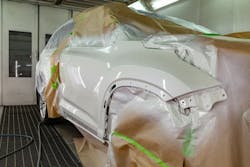Time required to blend is greater than for full refinish, SCRS study finds
Blending a panel that is adjacent to a panel being replaced or repaired is a necessary process to achieve a proper color match, and it is recommended by all the major automotive refinish companies in North America.
The three primary estimating system information providers (IPs) in the United States – Audatex, CCC/MOTOR and Mitchell - each define their own refinish times, and each establishes the labor for blend on a two-stage refinish by utilizing a formula of 50 percent of the full refinish value.
Collision repairers have routinely expressed that blending a panel takes more skill and time to facilitate an invisible transition than the existing formulas reflect.
SCRS worked with AkzoNobel Vehicle Refinishes, Axalta Coating Systems, BASF Automotive Refinish, PPG Industries and Sherwin-Williams Automotive Finishes to perform the research at the Global Finishing Solutions (GFS) Center for Excellence, at the GFS headquarters in Osseo, Wis.
The study utilized 45 new OEM parts, donated by Ford Motor Company, including hoods, fenders and front door shells for the 2018 Ford F-150, and was monitored and audited by DEKRA North America, the world’s largest unlisted expert organization in the TIC (testing, inspection, certification) industry.
The conclusions of this study indicate that blending, on average, took 31.59 percent more time than a full refinish, rather than the 50 percent less time allocated in the three IP estimating systems.
“The findings suggest that the concerns expressed by our members have not been unfounded,” stated SCRS Executive Director, Aaron Schulenburg. “These results very clearly establish that performing the processes necessary to blend a panel does not take less labor than the processes to fully refinish a panel.”
The study results conclude that the existing 50 percent formula may not be an accurate representation of the comparison between the two tasks.
At the conclusion of the test, all 45 parts donated by Ford Motor Company and 10 parts stands donated by 3M and SCRS, as well as miscellaneous materials from the research project, were donated to the Chippewa Valley Technical College (CVTC), in Eau Claire, Wis.
SCRS extends its gratitude to all the individuals and companies who made this research possible, with specific recognition of the contributions from 3M, AkzoNobel Vehicle Refinishes, Axalta Coating Systems, BASF Automotive Refinish, DEKRA North America, Ford Motor Company, Global Finishing Solutions, PPG Industries and Sherwin-Williams Automotive Finishes.
To download the Blend Study Report: A comparative analysis between full refinish and blend operations, visit www.scrs.com/blendstudy.
